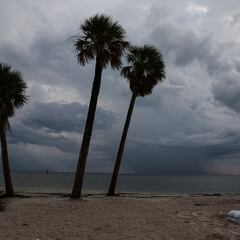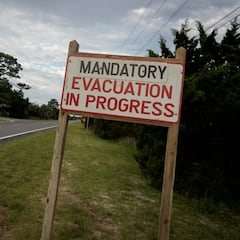Could Hurricanes Helene and John come together? These are the path forecasts
Hurricane John has made landfall in southern Mexico, while a weather system is expected to develop into a hurricane that could hit the U.S. Southeast.


Hurricane John has made landfall in Mexico after rapidly intensifying from a tropical storm to a category 3 hurricane with maximum sustained winds of approximately 105 mph.
The storm pummeled the country’s southern Pacific coast, bringing powerful winds and potentially heavy rainfall that could cause perilous flash floods. It is expected to bring extraordinary rainfall that could reach more than 10 inches in the states of Guerrero and Oaxaca.
READ ALSO: Potential Hurricane Helene on course to hit Florida
North America could see two devastating landfalls from Category 3+ hurricanes in under 72 hours.
— Colin McCarthy (@US_Stormwatch) September 23, 2024
Hurricane John is rapidly intensifying in the Eastern Pacific and is expected to slam into Oaxaca, Mexico tomorrow as a major hurricane, possibly making landfall as a Category 4… pic.twitter.com/PCfDMydICl
Meanwhile, another storm is brewing in the Caribbean Sea. An area of thunderstorms is expected to quickly develop into Hurricane Helene over the Gulf of Mexico before it makes landfall in the United States Gulf Coast later this week.
The National Hurricane Center says the storm has not yet formed, but it is expected to do do soon. The weather system is dubbed Potential Tropical Cyclone Nine or PTC9 as it develops, and will be named Helene once it reaches storm strength.
READ ALSO: Potential Hurricane Helene prompts State of Emergency in Florida
As we continue to monitor Potential Tropical Cyclone 9, here are the latest key messages from @NHC_Atlantic. Impacts to our area are forecast to arrive on Thursday, with heavy rain being the primary threat. #gawx #scwx pic.twitter.com/ONC8ER9Arm
— NWS Columbia (@NWSColumbia) September 24, 2024
Could Hurricanes Helene and John come together? These are the path forecasts
For the moment, there are no reports of the likelihood of the two weather systems converging. Hurricane John is expected to cause flash flooding and mudslides and southern areas of Mexico including Acapulco and Puerto Escondido through Thursday, according to the National Hurricane Center. It is forecast to move inland over southern Mexico and weaken rapidly as it travels over the mountainous terrain of the region.
The track of the weather system that is set to become Hurricane Helene on Wednesday goes northward, away from Hurricane John. There is still a high level of uncertainty among meteorologists regarding the exact location of landfall for Helene, although it is expected to first batter the Gulf Coast of the U.S. A hurricane watch is in effect for parts of Florida, as well as eastern portions of Mexico, and not the south.
Here is an interactive map from Windy.com so you can see a visual representation of the storm systems.
Can two hurricanes come together? What is the Fujiwhara effect?
Two hurricanes may join together if they are spinning in the same direction and pass close enough to each other, according to the National Weather Service.
Related stories
The Fujiwhara effect takes place when two cyclones move around each other and “begin an intense dance around their common center.” If one hurricane is considerably stronger that the other, the smaller one will be absorbed.
If they are similar in strength, they may spin around each other and eventually head into their own paths. On rare occasions, the two two hurricanes can come together and form a larger storm with more devastating effects.


Complete your personal details to comment